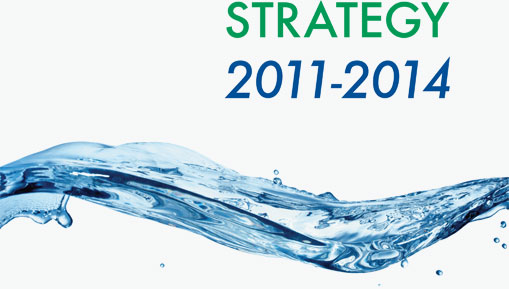 March 4, 2013 CONTACT: Chris Gilbride / Ted Timbers (718) 595-6600 Department of Environmental Protection Announces Substantial Progress Towards 100 Key Initiatives Set Forth in Strategic PlanAfter Two Years, 57 Projects Fully Achieved and 30 More to be Completed on ScheduleDepartment of Environmental Protection (DEP) Commissioner Carter Strickland today released the 2012 Progress Report on Strategy 2011-2014, which documents significant milestones reached during the two years since the groundbreaking plan was first introduced. Issued in 2011 with Mayor Bloomberg, the plan identified 100 distinct initiatives that will help DEP fulfill its mission to protect public health, improve water quality in the harbor, support economic development, and enhance New Yorkers’ overall quality of life by delivering high quality drinking water, managing stormwater, collecting and treating wastewater, and reducing air, noise, and hazardous materials pollution. At the plan’s mid-way point, 57 initiatives have been fully achieved, 30 are on track to be completed on schedule, and the remaining13 are in the planning and design phase. Significant accomplishments include an amended consent order that formalizes the inclusion of green infrastructure in DEP’s plan to reduce sewer overflows, completion of the first Green Infrastructure Demonstration Area, the installation of Automated Meter Reading devices that have saved customers more than $26 million through the Leak Notification Program, the launch of a Service Line Protection Program for the benefit of homeowners, the implementation of an increased and targeted maintenance program that has driven water main breaks down to the lowest level in ten years, the restoration of wetland habitats in Jamaica Bay, and the installation of nitrogen removal technology at the Wards Island and Hunts Points wastewater treatment plants. The full 2012 Progress Report can be viewed here. “Two years ago we set an ambitious agenda to reach our goal of becoming the safest, most efficient, cost-effective, and transparent water utility in the nation, and thanks to the dedication of the nearly 6,000 men and women at DEP we are well on our way to achieving that objective,” said Commissioner Strickland. “Despite being tested by Hurricane Sandy, the worst natural disaster in New York City’s history, as well as Hurricane Irene and Tropical Storm Lee a year earlier, DEP employees have shown their commitment to innovation across the board. I am proud to report that, in two years, we have accomplished more than half of the initiatives set forth in Strategy 2011-2014.” Operations and CapitalDEP has a vital responsibility to manage a vast system comprising 19 reservoirs, nearly 7,000 miles of water mains, tunnels, and aqueducts, 7,500 miles of sewers, 965 water quality monitoring stations, 109,500 fire hydrants, 148,000 catch basins, and 14 in-city wastewater treatment plants. In 2012, the resiliency of DEP’s wastewater conveyance and treatment system was tested by Hurricane Sandy and its record storm surge. Despite robust preparations, ten of 14 wastewater treatment plants and 42 of 96 pumping stations were severely flooded and experienced electrical failure. Thanks to the hardening of the system made possible by substantial financial commitments and the dedicated work of our employees, drinking water remained safe throughout the storm and DEP was able to treat 99 percent of wastewater within three days of the storm surge and 100 percent within two weeks. DEP’s ability to confront future operational challenges—both planned and unanticipated—is vital to the health, safety, and economic development of New York City and the upstate watersheds. To this end, DEP has the largest capital program of any city agency and one of the largest construction budgets in the region, with $11 billion in current construction and $3 billion more in the planning or design stages. Key 2012 Operations and Capital Milestones:
SustainabilityDEP promotes public health, economic development, and quality of life in New York City by developing sustainable environmental policies and enforcing regulations designed to reduce air and noise pollution and to control asbestos removal. DEP administers the city’s Air Pollution Control Code (Air Code), which is in the early phase of a major overhaul to update existing provisions and to include new strategies for improving the city’s air quality. Key 2012 Sustainability Milestones:
Customer ServiceDEP is committed to providing transparent, high-quality, and efficient customer service to the 836,000 customers who pay for the water and sewer services that fund the city’s water and wastewater system, the nine million people who use our water every day, including over eight million residents in New York City and nearly one million people who live in Westchester, Putnam, Ulster, and Orange counties, and the developers, engineers, construction companies, and plumbers that need DEP permits to continue the city’s growth. Key 2012 Customer Service Milestones:
Worker SafetyThe ambitious goals of Strategy 2011–2014 can only be met if conditions are safe for DEP’s nearly 6,000 employees. This requires continuous training, rigorous compliance oversight, and open communication among DEP staff. Key 2012 Worker Safety Milestones:
DEP manages New York City’s water supply, providing more than one billion gallons of water each day to more than nine million residents, including eight million in New York City. The water is delivered from a watershed that extends more than 125 miles from the city, comprising 19 reservoirs and three controlled lakes. Approximately 7,000 miles of water mains, tunnels and aqueducts bring water to homes and businesses throughout the five boroughs, and 7,500 miles of sewer lines and 96 pump stations take wastewater to 14 in-city treatment plants. DEP has nearly 6,000 employees, including almost 1,000 in the upstate watershed. In addition, DEP has a robust capital program, with a planned $14.4 billion in investments over the next 10 years that creates up to 3,000 construction-related jobs per year. For more information, visit www.nyc.gov/dep, like us on Facebook at www.facebook.com/nycwater, or follow us on Twitter at www.twitter.com/nycwater. | ||